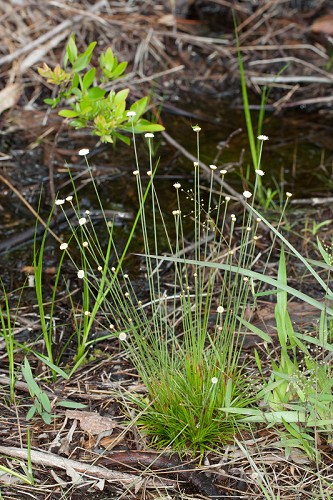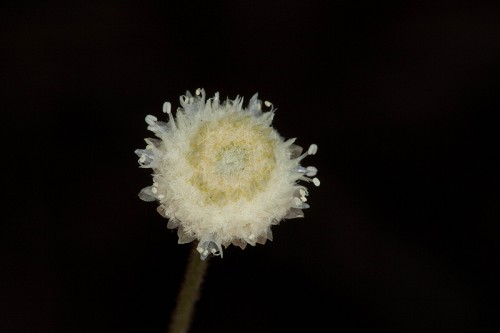Syngonanthus flavidulus
| Syngonanthus flavidulus | |
|---|---|

| |
| Photo by John R. Gwaltney, Southeastern Flora.com | |
| Scientific classification | |
| Kingdom: | Plantae |
| Division: | Magnoliophyta - Flowering plants |
| Class: | Liliopsida – Monocotyledons |
| Order: | Eriocaulales |
| Family: | Eriocaulaceae |
| Genus: | Syngonanthus |
| Species: | S. flavidulus |
| Binomial name | |
| Syngonanthus flavidulus (Michx.) Ruhl. | |

| |
| Natural range of Syngonanthus flavidulus from USDA NRCS Plants Database. | |
Common names: Yellow hatpins, Bantam-buttons
Contents
Taxonomic notes
Description
A description of Syngonanthus flavidulus is provided in The Flora of North America.
Distribution
S. flavidulus can be found in Alabama, Florida, Georgia, North Carolina, and South Carolina. It is ranked vulnerable in North Carolina and imperiled in Mississippi and South Carolina.[1]
Ecology
Habitat
In the Coastal Plain in Florida, S. flavidulus habitats include pine-oak woodlands, wet pine flatwoods, margins of cypress wetlands, sphagnous bogs, and powerline corridors.[2] S. flavidulus grows in areas of copious ground water seepage in poorly drained soils and sandy loam.
S. flavidulus had mixed changes in biomass in response to heavy silvilculture in north Florida flatwoods. It has shown both regrowth and resistance to regrowth in reestablished flatwoods that were disturbed by these practices.[3] It increased in frequency and biomass in response to soil disturbance by clearcutting and chopping in north Florida flatwoods forests.[4]
Syngonanathus flavidulus is an indicator species for the Central Florida Flatwoods/Prairies community type as described in Carr et al. (2010).[5]
Associated species include Lachnocaulon digynum, Sarracenia psittacina, Xyris drummondii, Drosera capillaries, Eriocaulon decangulare, Eryngium integrifolium, and Oxypolis filiformis.[6][2]
Phenology
Syngonanthus flavidulus flowers May through July.[7][8]
Seed bank and germination
This species was found viable in the seed bank of Florida pine flatwoods communities following fire after over 30 years of fire exclusion.[9]
Fire ecology
It has been observed growing in an annually burned longleaf pineland.[2]
Pollination and use by animals
Various Hymenoptera species were observed visiting flowers of Syngonanthus flavidulus at the Archbold Biological Station. These include plasterer bees from the Colletidae family (Colletes sp. and Hylaeus sp.), sweat bees from the Halictidae family (Agapostemon splendens, Augochlorella gratiosa, Augochloropsis sumptuosa, Halictus poeyi, Lasioglossum coreopsis, L. lepidii, L. nymphalis, L. puteulanum, L. tamiamensis and Sphecodes heraclei), wasps from the Leucospididae family (Leucospis robertsoni and L. slossonae), leafcutting bees from the Megachilidae family (Anthidiellum perplexum, Dianthidium floridiense, Hoplitis truncata and Megachile georgica), spider wasps from the Pompilidae family (Anoplius sp., Aporinellus apicatus and Episyron conterminus posterus), thread-waisted wasps from the Sphecidae family (Ammophila pictipennis, Bicyrtes capnoptera, Cerceris blakei, C. compar, Ectemnius decemmaculatus tequesta, E. rufipes ais, Hoplisoides placidus placidus, Microbembex monodonta, Oxybelus decorosum, O. laetus fulvipes, Philanthus ventilabris, Prionyx thomae, Stictiella serrata, Tachysphex apicalis, T. similis), and wasps from the Vespidae family (Leptochilus krombeini, L. republicanus, Pachodynerus erynnis, Parancistrocerus bicornis, P. fulvipes rufovestris, P. histrio, P. perennis anacardivora, P. salcularis rufulus, P. vagus slossoni, Pseudodynerus quadrisectus, Stenodynerus histrionalis rufustus, S. lineatifrons).[10] Additionally, the leafcutting bee Anthidiellum notatum (family Megachilidae) was also observed on this species.[11]
Conservation, cultivation, and restoration
Cultural use
Photo Gallery
Flowers of Syngonanthus flavidulus Photo by John R. Gwaltney, Southeastern Flora.com
References and notes
Florida State University Robert K. Godfrey Herbarium database. URL: http://herbarium.bio.fsu.edu. Last accessed: November 2015. Collectors: Loran C. Anderson, Bob Fewster, Robert K. Godfrey, R. Komarek, Marc Minno, R.A. Norris, Cecil R. Slaughter. States and Counties: Florida: Flagler, Franklin, Leon, Liberty, Wakulla. Georgia: Clinch, Thomas. Compiled by Tall Timbers Research Station and Land Conservancy.
- ↑ [[1]]NatureServe. Accessed: March 17, 2016
- ↑ 2.0 2.1 2.2 Florida State University Robert K. Godfrey Herbarium database. URL: http://herbarium.bio.fsu.edu. Last accessed: November 2015. Collectors: Loran C. Anderson, Bob Fewster, Robert K. Godfrey, R. Komarek, Marc Minno, R.A. Norris, Cecil R. Slaughter. States and Counties: Florida: Flagler, Franklin, Leon, Liberty, Wakulla. Georgia: Clinch, Thomas. Compiled by Tall Timbers Research Station and Land Conservancy.
- ↑ Conde, L.F., B.F. Swindel, and J.E. Smith. (1986). Five Years of Vegetation Changes Following Conversion of Pine Flatwoods to Pinus elliottii Plantations. Forest Ecology and Management 15(4):295-300.
- ↑ Moore, W.H., B.F. Swindel, and W.S. Terry. (1982). Vegetative Response to Clearcutting and Chopping in a North Florida Flatwoods Forest. Journal of Range Management 35(2):214-218.
- ↑ Carr, S.C., K.M. Robertson, and R.K. Peet. 2010. A vegetation classification of fire-dependent pinelands of Florida. Castanea 75:153-189.
- ↑ Bridges, E. L. and S. L. Orzell (1989). "SYNGONANTHUS FLAVIDULUS (ERIOCAULACEAE) NEW TO MISSISSIPPI." SIDA, Contributions to Botany 13(4): 512-515.
- ↑ [[2]]Encyclopedia of Life. Accessed: March 17, 2016
- ↑ Nelson, G. PanFlora: Plant data for the eastern United States with emphasis on the Southeastern Coastal Plains, Florida, and the Florida Panhandle. www.gilnelson.com/PanFlora/ Accessed: 19 MAY 2021
- ↑ Maliakal, S.K., E.S. Menges and J.S. Denslow. 2000. Community composition and regeneration of Lake Wales Ridge wiregrass flatwoods in retlation to time-since-fire. Journal of the Torrey Botanical Society 127:125-138.
- ↑ Deyrup, M.A. and N.D. 2015. Database of observations of Hymenoptera visitations to flowers of plants on Archbold Biological Station, Florida, USA.
- ↑ Discoverlife.org [3]
